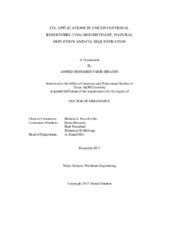| dc.description.abstract | Unconventional reservoirs are getting an increase in attention in the oil and gas industry. This is because of the high energy demands from all over the world, which cannot be satisfied by conventional resources alone. Coalbed methane (CBM) currently accounts for approximately 5% of U.S. annual gas production. The performance prediction of CBM is very complex. It is highly affected by the complexity of porosity-permeability variation, reduction due to formation compaction, enhancement due to matrix shrinkage, and the two-phase flow effects. An additional complexity is added if the initial gas content, permeability, and porosity are not available. Also, CO₂ sequestration in coal seams is an attractive carbon sequestration technology where the injection of CO2 enhances methane production from coalbeds (ECBM) in addition to storing CO₂.
The main objectives of this work are to: (1) develop an integrated model to simulate the b behavior of CBM; A developed generalized material balance equation will be used to account for the solubility of the methane in water, and the changes of porosity and permeability with pressure depletion; (2) Extend the model to simulate the performance of ECBM; (3) evaluate the role of brine salinity, formation pressure and gas composition on the CO₂-water-coal wettability; and (4) examine the effect of the water salinity, gas composition, formation pressure, and injection flow rate on the performance of CO₂ sequestration in coal cores.
In order to achieve the proposed objectives, a generalized material balance equation is developed to account for the solubility of the methane in water and the changes of porosity and permeability with pressure depletion. An optimization algorithm was also used with the integrated model. The model could be used as a history-matching tool to estimate the original gas-in-place (the adsorbed gas-in-place and the free gas-in-place), the initial formation permeability, the gas and water relative permeability exponents, and the matrix shrinkage coefficient that reflected the permeability changes.
The model was then extended to simulate the performance of ECBM. A compositional material balance (CMB) was used to track the propagation of CO₂ concentration in the reservoir. CMB was combined with the stream tube concept to convert a 2D to a 1D problem. An optimization algorithm was also used with the integrated model. The integrated model could be used as a history-matching tool to estimate the initial formation permeability, the initial formation porosity, the matrix shrinkage, and swelling coefficients that reflected the permeability changes.
In addition, coal blocks were collected from the Bull Hill mine in Oklahoma to be used in the experimental work. The coal sample was characterized using SEM/EDS and proximate thermogravimetric analysis. It was found that the coal sample contains a high carbon content of 82 wt%. Based on these measurements, this coal sample was classified as high volatile bitumen coal. The effects of the injected gas composition and the formation water salinity on the wettability behavior of high volatile bitumen coal will be investigated. The captive bubble method will be used to measure the contact angle in coal– water–CO₂ systems at pressures up to 2,000 psi. The contact angle (CA) will be measured at different NaCl concentrations (0-20 g/l). Flue gasses with different nitrogen concentrations will be used to examine the effect of gas composition on wettability behavior. CO₂ adsorption isotherm on the coal surface will be examined at different water salinities. Zeta potential measurements will be conducted to understand the effect of salt concentration on coal hydrophobicity. Coreflood tests will be conducted on different coal cores. The change in the effective water-coal permeability after a CO₂ injection will be examined. Also, the displacement efficiency of water by CO₂ will be estimated. The experimental data will be cross-matched with a numerical simulation to estimate the relative permeability curves. | en |


